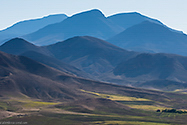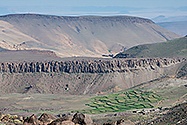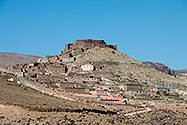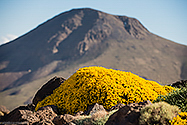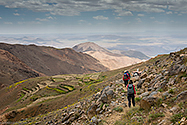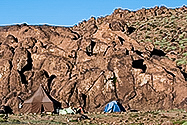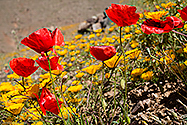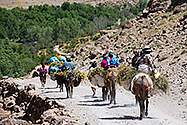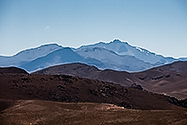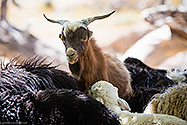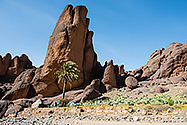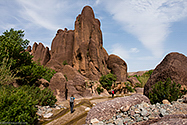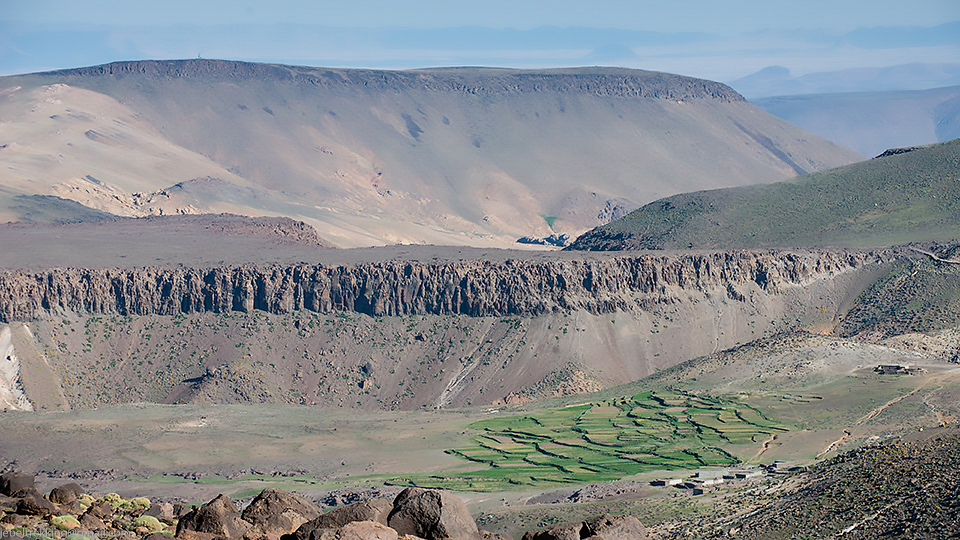
A volcanic peak, a scenic gorge and saffron fields in Siroua
Siroua is a part of the Anti-Atlas range, where a fascinating desolate and barren landscape contrasts sharply with beautiful green, cultivated and inhabited areas. We walk through the beautiful Tizgi Valley, dotted with small villages amongst terraced fields where walnuts, almonds and saffron are grown. One of the highlights of the tour is a climb to the lone volcanic peak of Mount Siroua. Another unforgettable experience is the beautiful, scenic Tislit Gorge.
The tour day by day
Day one: Marrakech – Tamelakot – Tizouad (3 to 3,5 trekking hours)
Setting off from Marrakech towards the south-east, we approach High Atlas, leaving the flat country behind us. We drive on serpentine roads up to the Tizi n´Tichka Pass at 2 260 meters. From up here the panoramic views are magnificent. After a four hour drive we turn off onto a small road that leads to the village Tamelakot, the starting point for our trek. The village is situated at about 1 500 meters and here we meet our mule drivers, who load up the mules for us.
The trek begins on a plateau and continues along a little gravel road, where the only traffic we meet are the local transports from the market. We walk through a landscape with low bushes and mountains. Further on the views expand and the profiles of impressive towering mountains can be seen in the distance. Among them is Mount Siroua (3 300 m) that we will climb on day three.
We pass by the village of Tamazirt, where the colours of the buildings melt into the barren landscape, in sharp contrast to green cultivated patches near the village. Close to the village we see some peculiar formations that remind us that we are walking in an old volcanic mountain area. We pitch or camp for the night in the outskirts of the village Tizouad near the fields of barley, maize, almonds and saffron.
Day two: Tizouad – Azib Tisouitin (5,5 to 6 trekking hours)
Today’s leg takes us gently upwards, past several farmed fields. We follow a little gravel road to the village of Aït Irmour, charmingly situated on a hill surrounded by barren mountains. The earthen-coloured stone houses climb up the mountain side and above the village towers the fortified granary. Here, in bygone times, people kept their money and other valuables under the guardianship of the villagers.
We go by more villages and hike through a beautiful terraced area where the local inhabitants grow their crops. We pass walnut groves and fertile summer grazing grounds for goats, sheep and cows. As we continue upwards the natural scenery changes and we enter a stony and infertile landscape, with only a few pockets of intensive green.
Our trek takes us up over mountains that are covered with bushes seasonally flowering in yellow and purple. Here at a little higher level, we are treated to stunning views over majestic mountains, wide-stretched plateaus, impressive slopes and valleys with beautifully terraced fields.
We camp for the night on a little plateau at Azib Tisouitin, situated at 2 600 meters, right under the face of a beautiful reddish-brown cliff. From here we enjoy far-reaching views over the Tisouitin Valley and distant mountains fading into blue.
Day three: Azib Tisouitin – Arbelou (6 to 7 trekking hours)
At the crack of dawn, five thirty in the morning, we get up to prepare for the climb to the summit of Mount Siroua (3 304 m), a lone volcanic peak. The summit is quite easy to reach, even for non-climbers. From our camp site it takes 3,5 hours to reach the top.
We begin the day by walking on a gentle upward slope through a small valley. Then we follow a little path taking us further on up to the mountain ridge just below the summit. From here we use our hands to help us climb up the last hundred meters. From the top we have stunning views of the surroundings, including Mount Toubkal, Morocco´s highest mountain, 4 167 meters high. Even those who chose to stay on the ridge below the summit are richly rewarded with fantastic views.
We retrace our steps and continue down to a serene valley with low mountains on both sides. The rest of the day’s trek goes through a wild and barren landscape without any villages, and the vegetation consists only of low bushes.
Our goal today is Arbelou, a beautiful place by a spring in the valley and with great mountain views. Here at 2 200 meters, where villagers grow their grain and keep their animals to graze in the summer, we camp for the night.
Day four: Arbelou – Tislit Gorge (6 to 6,5 trekking hours)
Today we walk downwards almost all day and yesterday’s desolate landscape is replaced by the broad and blooming Tizgi Valley. We begin however, by walking up to a little pass from where we have a fine view down into the valley, and behind us to Mount Siroua’s majestic summit.
We walk through this stunningly beautiful and far-reaching valley where the villages lie close to each other. One of these is the lovely little village of Tizgi, with its traditional old houses. The colours of the houses match that of the reddish-brown mountain sides sloping gently on both sides of the valley. We wander through the villages, and also pass more interesting fortified granaries and beautiful terraced fields with Almond and Walnut trees. Siroua is famous for its fine saffron and its handmade carpets of high quality. Perhaps we will be invited into a family house to see the women weaving carpets and to have a glass off Moroccan saffron tea.
We continue down towards our camp for the night and are treated to wonderful views over the surrounding landscape. Our tents are pitched a few hundred meters from the amazing Tislit Gorge, one of the highlights of our trek, close to a riverbed and with a view of the scenic mountains at the mouth of the gorge.
In the evening we take a walk along the riverbed running through the gorge. Depending on the depth of the water, and if it is not too cold, we can hear the many beautifully coloured toads singing a serenade in the pools of water between sandbanks in the river. If we are lucky, we can spot the shy fox up on the mountain side.
Day five: Tislit Gorge – Ifrane (5,5 to 6 trekking hours)
Our last trekking day we walk through the beautiful Tislit Gorge, which narrows more and more as we come deeper into it. The gorge is bordered by huge boulders and strange reddish-brown and dark grey mountain sides.
We pass a lovely place where an unexpected solitary palm tree stands on a grassy spot, covered with Fig cactuses, and then continue wandering along the small meandering river. At the end of the gorge we approach Tislit Village, where the women are known for their production of rugs woven in traditional patterns.
We go on along a stony, bare mountain side down into the verdant Tislit Valley. After a while we pass the very old village of Ihokarem, where the houses are built of clay mixed with the grass of barley. In the village of Ifrane we spend our last night on our trek in a Berber family house.
Day six: Tislit – Marrakech
All that is left now is our return trip to Marrakech, where we will arrive in the afternoon. The drive goes through the beautiful Oued Nfis Valley and up over the spectacular Tizi’n Test Pass at 2 092 meters. We stop to visit the impressive and interesting Tin Mal Mosque, which is on the UNESCO Tentative World Heritage List, and one of the few mosques that also welcomes non-Muslim visitors.

